Choosing the Right Business Structure
VerifiedAdded on 2020/03/28
|11
|3752
|149
AI Summary
This assignment delves into the different types of business structures available to entrepreneurs, including sole proprietorships, partnerships, S corporations, C corporations, and limited liability companies (LLCs). It highlights the key features, advantages, and disadvantages of each structure, emphasizing factors like liability protection, taxation, fundraising capabilities, and operational flexibility. The goal is to provide a comprehensive understanding of these options to help individuals make informed decisions about the most suitable structure for their specific business needs.
Contribute Materials
Your contribution can guide someone’s learning journey. Share your
documents today.
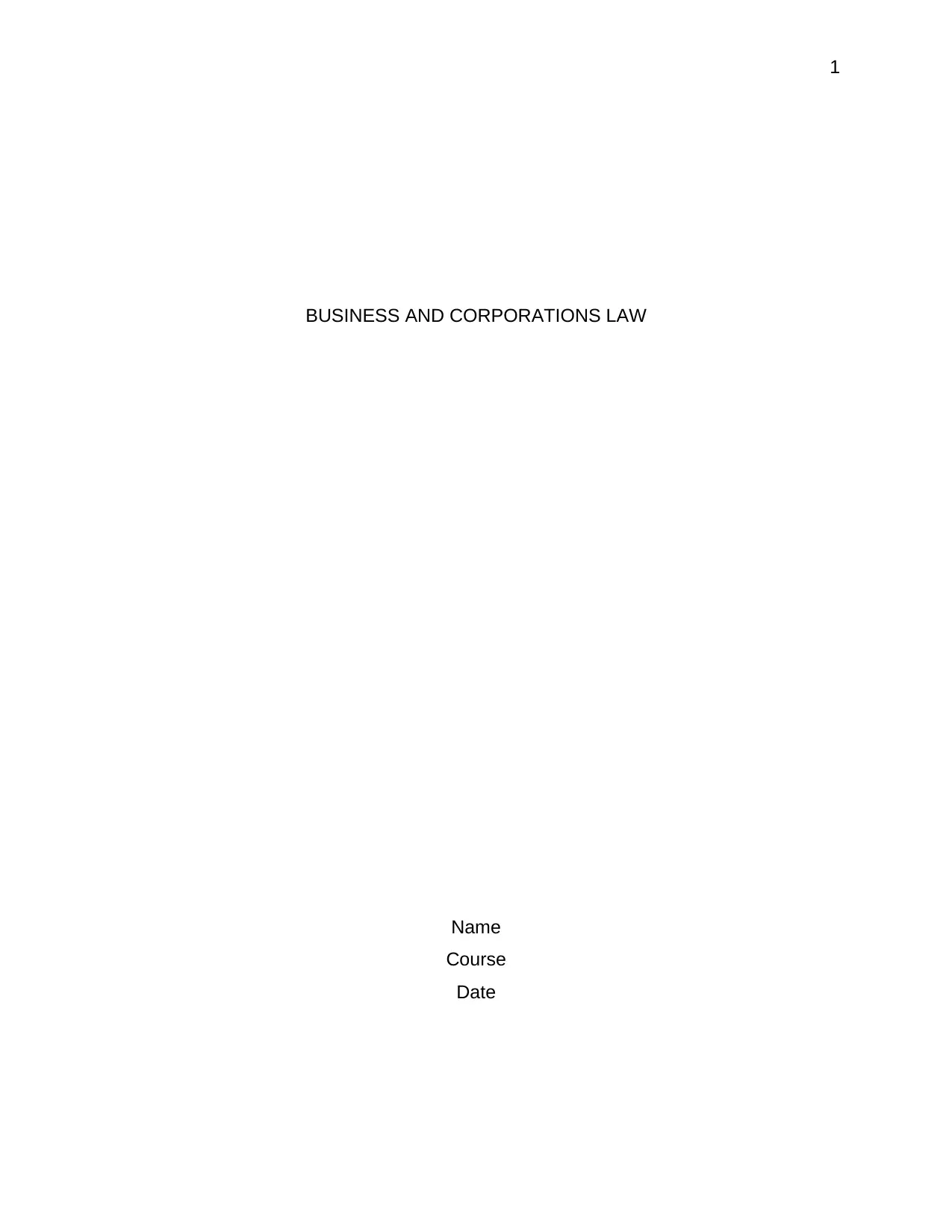
1
BUSINESS AND CORPORATIONS LAW
Name
Course
Date
BUSINESS AND CORPORATIONS LAW
Name
Course
Date
Secure Best Marks with AI Grader
Need help grading? Try our AI Grader for instant feedback on your assignments.
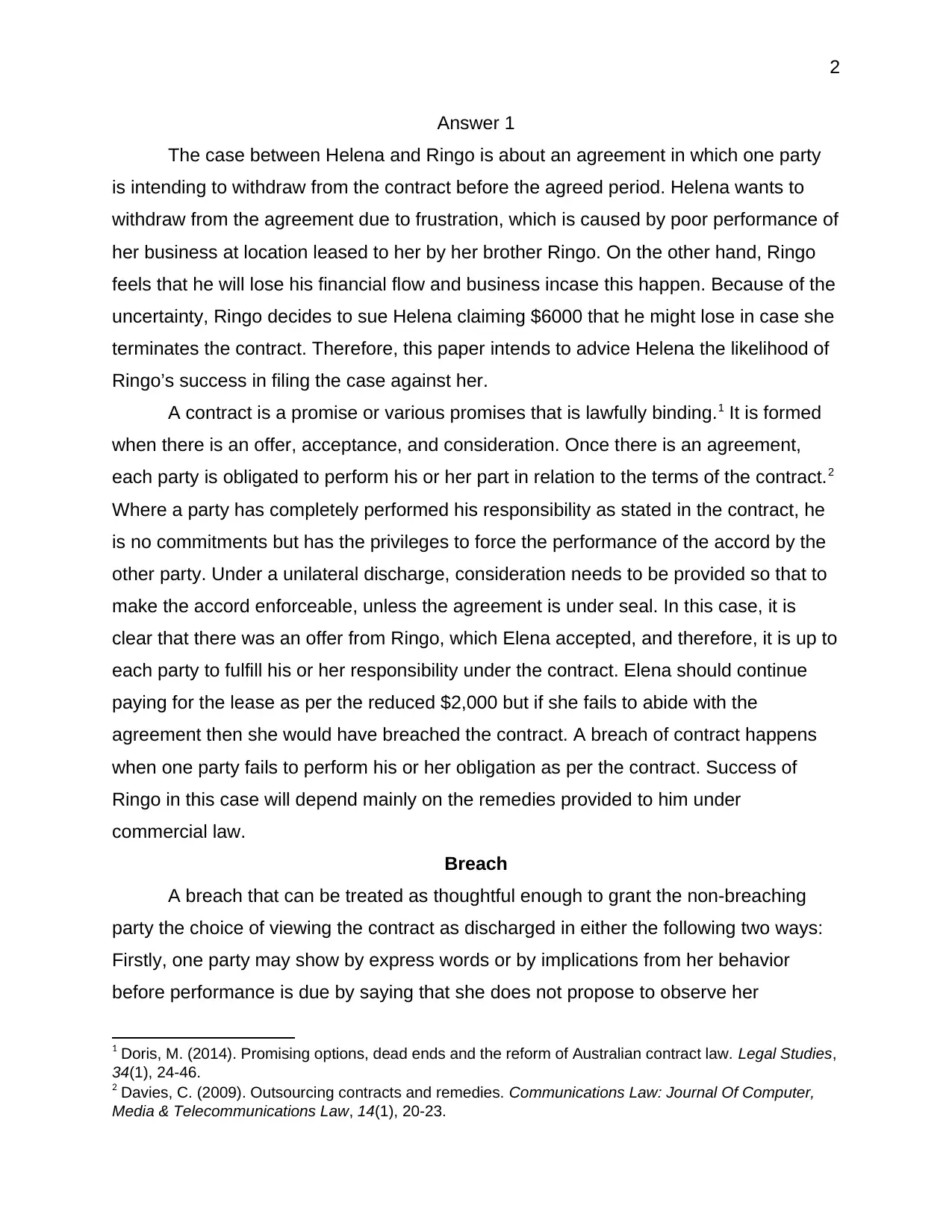
2
Answer 1
The case between Helena and Ringo is about an agreement in which one party
is intending to withdraw from the contract before the agreed period. Helena wants to
withdraw from the agreement due to frustration, which is caused by poor performance of
her business at location leased to her by her brother Ringo. On the other hand, Ringo
feels that he will lose his financial flow and business incase this happen. Because of the
uncertainty, Ringo decides to sue Helena claiming $6000 that he might lose in case she
terminates the contract. Therefore, this paper intends to advice Helena the likelihood of
Ringo’s success in filing the case against her.
A contract is a promise or various promises that is lawfully binding.1 It is formed
when there is an offer, acceptance, and consideration. Once there is an agreement,
each party is obligated to perform his or her part in relation to the terms of the contract.2
Where a party has completely performed his responsibility as stated in the contract, he
is no commitments but has the privileges to force the performance of the accord by the
other party. Under a unilateral discharge, consideration needs to be provided so that to
make the accord enforceable, unless the agreement is under seal. In this case, it is
clear that there was an offer from Ringo, which Elena accepted, and therefore, it is up to
each party to fulfill his or her responsibility under the contract. Elena should continue
paying for the lease as per the reduced $2,000 but if she fails to abide with the
agreement then she would have breached the contract. A breach of contract happens
when one party fails to perform his or her obligation as per the contract. Success of
Ringo in this case will depend mainly on the remedies provided to him under
commercial law.
Breach
A breach that can be treated as thoughtful enough to grant the non-breaching
party the choice of viewing the contract as discharged in either the following two ways:
Firstly, one party may show by express words or by implications from her behavior
before performance is due by saying that she does not propose to observe her
1 Doris, M. (2014). Promising options, dead ends and the reform of Australian contract law. Legal Studies,
34(1), 24-46.
2 Davies, C. (2009). Outsourcing contracts and remedies. Communications Law: Journal Of Computer,
Media & Telecommunications Law, 14(1), 20-23.
Answer 1
The case between Helena and Ringo is about an agreement in which one party
is intending to withdraw from the contract before the agreed period. Helena wants to
withdraw from the agreement due to frustration, which is caused by poor performance of
her business at location leased to her by her brother Ringo. On the other hand, Ringo
feels that he will lose his financial flow and business incase this happen. Because of the
uncertainty, Ringo decides to sue Helena claiming $6000 that he might lose in case she
terminates the contract. Therefore, this paper intends to advice Helena the likelihood of
Ringo’s success in filing the case against her.
A contract is a promise or various promises that is lawfully binding.1 It is formed
when there is an offer, acceptance, and consideration. Once there is an agreement,
each party is obligated to perform his or her part in relation to the terms of the contract.2
Where a party has completely performed his responsibility as stated in the contract, he
is no commitments but has the privileges to force the performance of the accord by the
other party. Under a unilateral discharge, consideration needs to be provided so that to
make the accord enforceable, unless the agreement is under seal. In this case, it is
clear that there was an offer from Ringo, which Elena accepted, and therefore, it is up to
each party to fulfill his or her responsibility under the contract. Elena should continue
paying for the lease as per the reduced $2,000 but if she fails to abide with the
agreement then she would have breached the contract. A breach of contract happens
when one party fails to perform his or her obligation as per the contract. Success of
Ringo in this case will depend mainly on the remedies provided to him under
commercial law.
Breach
A breach that can be treated as thoughtful enough to grant the non-breaching
party the choice of viewing the contract as discharged in either the following two ways:
Firstly, one party may show by express words or by implications from her behavior
before performance is due by saying that she does not propose to observe her
1 Doris, M. (2014). Promising options, dead ends and the reform of Australian contract law. Legal Studies,
34(1), 24-46.
2 Davies, C. (2009). Outsourcing contracts and remedies. Communications Law: Journal Of Computer,
Media & Telecommunications Law, 14(1), 20-23.
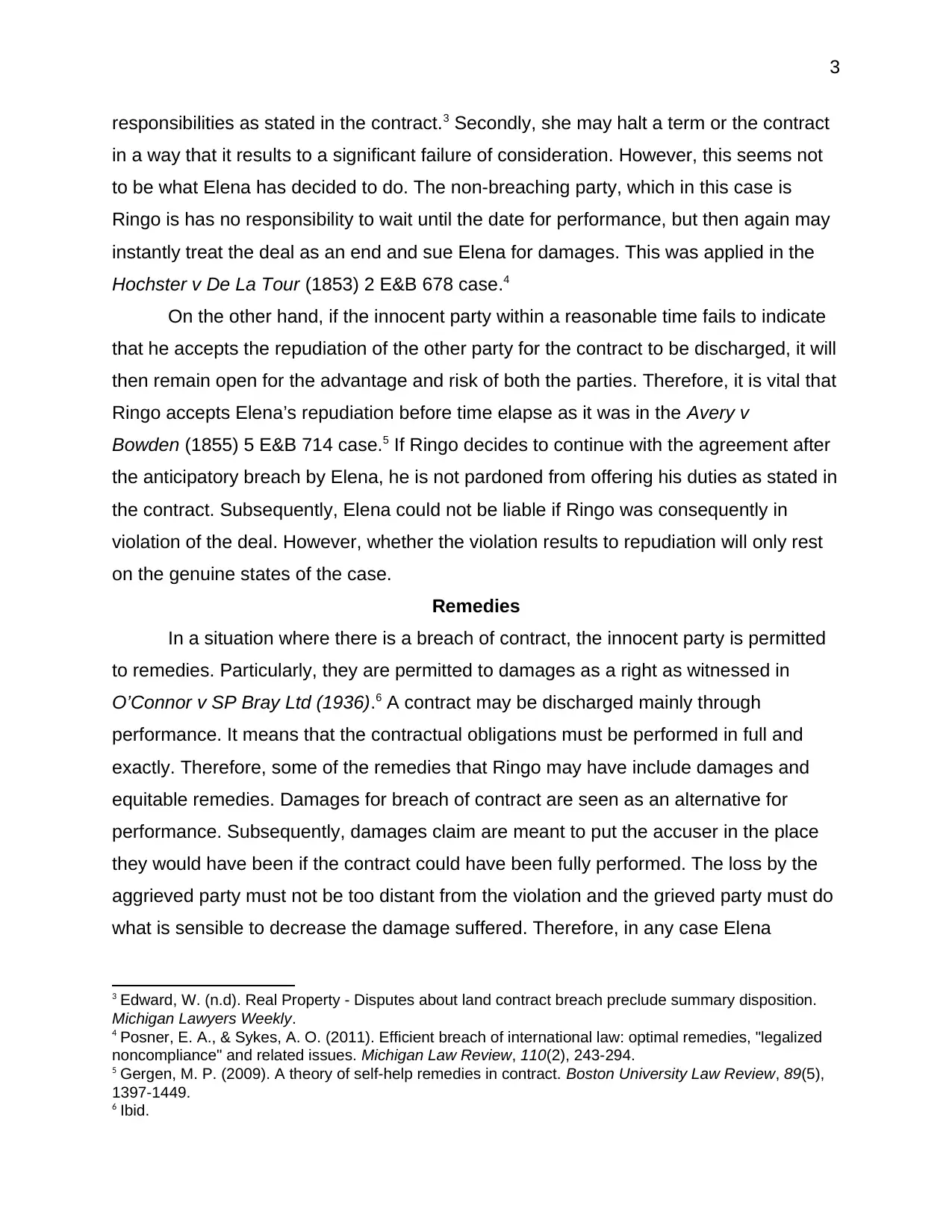
3
responsibilities as stated in the contract.3 Secondly, she may halt a term or the contract
in a way that it results to a significant failure of consideration. However, this seems not
to be what Elena has decided to do. The non-breaching party, which in this case is
Ringo is has no responsibility to wait until the date for performance, but then again may
instantly treat the deal as an end and sue Elena for damages. This was applied in the
Hochster v De La Tour (1853) 2 E&B 678 case.4
On the other hand, if the innocent party within a reasonable time fails to indicate
that he accepts the repudiation of the other party for the contract to be discharged, it will
then remain open for the advantage and risk of both the parties. Therefore, it is vital that
Ringo accepts Elena’s repudiation before time elapse as it was in the Avery v
Bowden (1855) 5 E&B 714 case.5 If Ringo decides to continue with the agreement after
the anticipatory breach by Elena, he is not pardoned from offering his duties as stated in
the contract. Subsequently, Elena could not be liable if Ringo was consequently in
violation of the deal. However, whether the violation results to repudiation will only rest
on the genuine states of the case.
Remedies
In a situation where there is a breach of contract, the innocent party is permitted
to remedies. Particularly, they are permitted to damages as a right as witnessed in
O’Connor v SP Bray Ltd (1936).6 A contract may be discharged mainly through
performance. It means that the contractual obligations must be performed in full and
exactly. Therefore, some of the remedies that Ringo may have include damages and
equitable remedies. Damages for breach of contract are seen as an alternative for
performance. Subsequently, damages claim are meant to put the accuser in the place
they would have been if the contract could have been fully performed. The loss by the
aggrieved party must not be too distant from the violation and the grieved party must do
what is sensible to decrease the damage suffered. Therefore, in any case Elena
3 Edward, W. (n.d). Real Property - Disputes about land contract breach preclude summary disposition.
Michigan Lawyers Weekly.
4 Posner, E. A., & Sykes, A. O. (2011). Efficient breach of international law: optimal remedies, "legalized
noncompliance" and related issues. Michigan Law Review, 110(2), 243-294.
5 Gergen, M. P. (2009). A theory of self-help remedies in contract. Boston University Law Review, 89(5),
1397-1449.
6 Ibid.
responsibilities as stated in the contract.3 Secondly, she may halt a term or the contract
in a way that it results to a significant failure of consideration. However, this seems not
to be what Elena has decided to do. The non-breaching party, which in this case is
Ringo is has no responsibility to wait until the date for performance, but then again may
instantly treat the deal as an end and sue Elena for damages. This was applied in the
Hochster v De La Tour (1853) 2 E&B 678 case.4
On the other hand, if the innocent party within a reasonable time fails to indicate
that he accepts the repudiation of the other party for the contract to be discharged, it will
then remain open for the advantage and risk of both the parties. Therefore, it is vital that
Ringo accepts Elena’s repudiation before time elapse as it was in the Avery v
Bowden (1855) 5 E&B 714 case.5 If Ringo decides to continue with the agreement after
the anticipatory breach by Elena, he is not pardoned from offering his duties as stated in
the contract. Subsequently, Elena could not be liable if Ringo was consequently in
violation of the deal. However, whether the violation results to repudiation will only rest
on the genuine states of the case.
Remedies
In a situation where there is a breach of contract, the innocent party is permitted
to remedies. Particularly, they are permitted to damages as a right as witnessed in
O’Connor v SP Bray Ltd (1936).6 A contract may be discharged mainly through
performance. It means that the contractual obligations must be performed in full and
exactly. Therefore, some of the remedies that Ringo may have include damages and
equitable remedies. Damages for breach of contract are seen as an alternative for
performance. Subsequently, damages claim are meant to put the accuser in the place
they would have been if the contract could have been fully performed. The loss by the
aggrieved party must not be too distant from the violation and the grieved party must do
what is sensible to decrease the damage suffered. Therefore, in any case Elena
3 Edward, W. (n.d). Real Property - Disputes about land contract breach preclude summary disposition.
Michigan Lawyers Weekly.
4 Posner, E. A., & Sykes, A. O. (2011). Efficient breach of international law: optimal remedies, "legalized
noncompliance" and related issues. Michigan Law Review, 110(2), 243-294.
5 Gergen, M. P. (2009). A theory of self-help remedies in contract. Boston University Law Review, 89(5),
1397-1449.
6 Ibid.
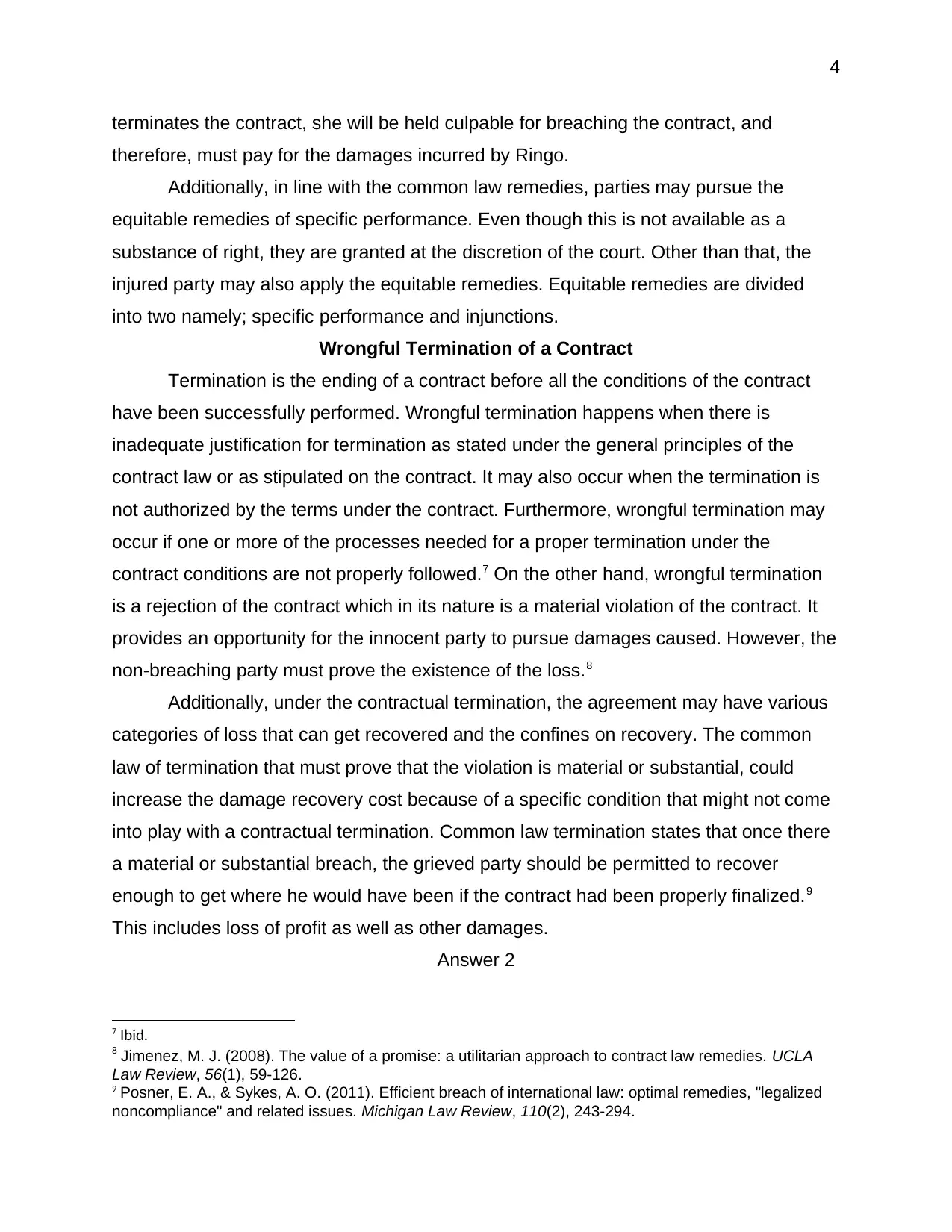
4
terminates the contract, she will be held culpable for breaching the contract, and
therefore, must pay for the damages incurred by Ringo.
Additionally, in line with the common law remedies, parties may pursue the
equitable remedies of specific performance. Even though this is not available as a
substance of right, they are granted at the discretion of the court. Other than that, the
injured party may also apply the equitable remedies. Equitable remedies are divided
into two namely; specific performance and injunctions.
Wrongful Termination of a Contract
Termination is the ending of a contract before all the conditions of the contract
have been successfully performed. Wrongful termination happens when there is
inadequate justification for termination as stated under the general principles of the
contract law or as stipulated on the contract. It may also occur when the termination is
not authorized by the terms under the contract. Furthermore, wrongful termination may
occur if one or more of the processes needed for a proper termination under the
contract conditions are not properly followed.7 On the other hand, wrongful termination
is a rejection of the contract which in its nature is a material violation of the contract. It
provides an opportunity for the innocent party to pursue damages caused. However, the
non-breaching party must prove the existence of the loss.8
Additionally, under the contractual termination, the agreement may have various
categories of loss that can get recovered and the confines on recovery. The common
law of termination that must prove that the violation is material or substantial, could
increase the damage recovery cost because of a specific condition that might not come
into play with a contractual termination. Common law termination states that once there
a material or substantial breach, the grieved party should be permitted to recover
enough to get where he would have been if the contract had been properly finalized.9
This includes loss of profit as well as other damages.
Answer 2
7 Ibid.
8 Jimenez, M. J. (2008). The value of a promise: a utilitarian approach to contract law remedies. UCLA
Law Review, 56(1), 59-126.
9 Posner, E. A., & Sykes, A. O. (2011). Efficient breach of international law: optimal remedies, "legalized
noncompliance" and related issues. Michigan Law Review, 110(2), 243-294.
terminates the contract, she will be held culpable for breaching the contract, and
therefore, must pay for the damages incurred by Ringo.
Additionally, in line with the common law remedies, parties may pursue the
equitable remedies of specific performance. Even though this is not available as a
substance of right, they are granted at the discretion of the court. Other than that, the
injured party may also apply the equitable remedies. Equitable remedies are divided
into two namely; specific performance and injunctions.
Wrongful Termination of a Contract
Termination is the ending of a contract before all the conditions of the contract
have been successfully performed. Wrongful termination happens when there is
inadequate justification for termination as stated under the general principles of the
contract law or as stipulated on the contract. It may also occur when the termination is
not authorized by the terms under the contract. Furthermore, wrongful termination may
occur if one or more of the processes needed for a proper termination under the
contract conditions are not properly followed.7 On the other hand, wrongful termination
is a rejection of the contract which in its nature is a material violation of the contract. It
provides an opportunity for the innocent party to pursue damages caused. However, the
non-breaching party must prove the existence of the loss.8
Additionally, under the contractual termination, the agreement may have various
categories of loss that can get recovered and the confines on recovery. The common
law of termination that must prove that the violation is material or substantial, could
increase the damage recovery cost because of a specific condition that might not come
into play with a contractual termination. Common law termination states that once there
a material or substantial breach, the grieved party should be permitted to recover
enough to get where he would have been if the contract had been properly finalized.9
This includes loss of profit as well as other damages.
Answer 2
7 Ibid.
8 Jimenez, M. J. (2008). The value of a promise: a utilitarian approach to contract law remedies. UCLA
Law Review, 56(1), 59-126.
9 Posner, E. A., & Sykes, A. O. (2011). Efficient breach of international law: optimal remedies, "legalized
noncompliance" and related issues. Michigan Law Review, 110(2), 243-294.
Secure Best Marks with AI Grader
Need help grading? Try our AI Grader for instant feedback on your assignments.
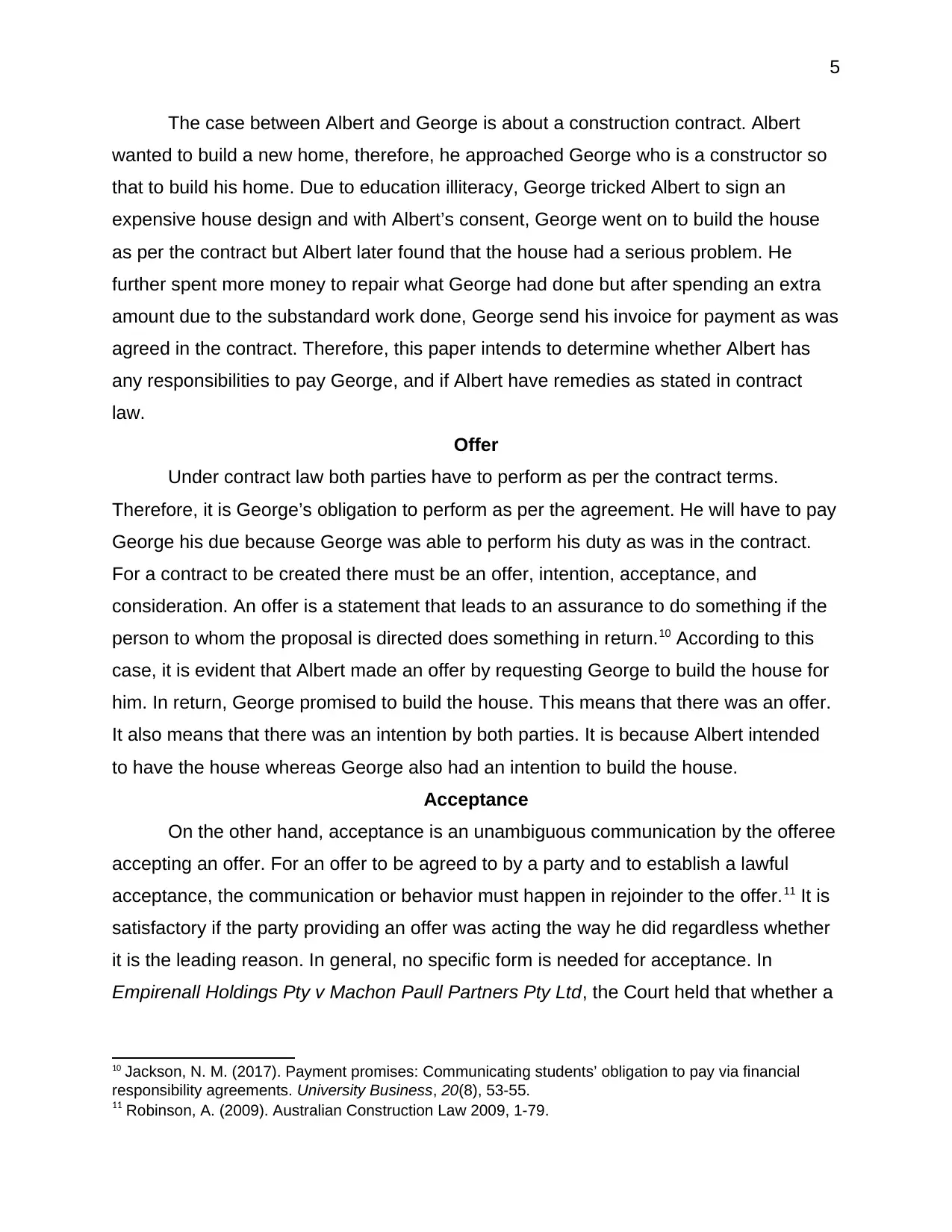
5
The case between Albert and George is about a construction contract. Albert
wanted to build a new home, therefore, he approached George who is a constructor so
that to build his home. Due to education illiteracy, George tricked Albert to sign an
expensive house design and with Albert’s consent, George went on to build the house
as per the contract but Albert later found that the house had a serious problem. He
further spent more money to repair what George had done but after spending an extra
amount due to the substandard work done, George send his invoice for payment as was
agreed in the contract. Therefore, this paper intends to determine whether Albert has
any responsibilities to pay George, and if Albert have remedies as stated in contract
law.
Offer
Under contract law both parties have to perform as per the contract terms.
Therefore, it is George’s obligation to perform as per the agreement. He will have to pay
George his due because George was able to perform his duty as was in the contract.
For a contract to be created there must be an offer, intention, acceptance, and
consideration. An offer is a statement that leads to an assurance to do something if the
person to whom the proposal is directed does something in return.10 According to this
case, it is evident that Albert made an offer by requesting George to build the house for
him. In return, George promised to build the house. This means that there was an offer.
It also means that there was an intention by both parties. It is because Albert intended
to have the house whereas George also had an intention to build the house.
Acceptance
On the other hand, acceptance is an unambiguous communication by the offeree
accepting an offer. For an offer to be agreed to by a party and to establish a lawful
acceptance, the communication or behavior must happen in rejoinder to the offer.11 It is
satisfactory if the party providing an offer was acting the way he did regardless whether
it is the leading reason. In general, no specific form is needed for acceptance. In
Empirenall Holdings Pty v Machon Paull Partners Pty Ltd, the Court held that whether a
10 Jackson, N. M. (2017). Payment promises: Communicating students’ obligation to pay via financial
responsibility agreements. University Business, 20(8), 53-55.
11 Robinson, A. (2009). Australian Construction Law 2009, 1-79.
The case between Albert and George is about a construction contract. Albert
wanted to build a new home, therefore, he approached George who is a constructor so
that to build his home. Due to education illiteracy, George tricked Albert to sign an
expensive house design and with Albert’s consent, George went on to build the house
as per the contract but Albert later found that the house had a serious problem. He
further spent more money to repair what George had done but after spending an extra
amount due to the substandard work done, George send his invoice for payment as was
agreed in the contract. Therefore, this paper intends to determine whether Albert has
any responsibilities to pay George, and if Albert have remedies as stated in contract
law.
Offer
Under contract law both parties have to perform as per the contract terms.
Therefore, it is George’s obligation to perform as per the agreement. He will have to pay
George his due because George was able to perform his duty as was in the contract.
For a contract to be created there must be an offer, intention, acceptance, and
consideration. An offer is a statement that leads to an assurance to do something if the
person to whom the proposal is directed does something in return.10 According to this
case, it is evident that Albert made an offer by requesting George to build the house for
him. In return, George promised to build the house. This means that there was an offer.
It also means that there was an intention by both parties. It is because Albert intended
to have the house whereas George also had an intention to build the house.
Acceptance
On the other hand, acceptance is an unambiguous communication by the offeree
accepting an offer. For an offer to be agreed to by a party and to establish a lawful
acceptance, the communication or behavior must happen in rejoinder to the offer.11 It is
satisfactory if the party providing an offer was acting the way he did regardless whether
it is the leading reason. In general, no specific form is needed for acceptance. In
Empirenall Holdings Pty v Machon Paull Partners Pty Ltd, the Court held that whether a
10 Jackson, N. M. (2017). Payment promises: Communicating students’ obligation to pay via financial
responsibility agreements. University Business, 20(8), 53-55.
11 Robinson, A. (2009). Australian Construction Law 2009, 1-79.
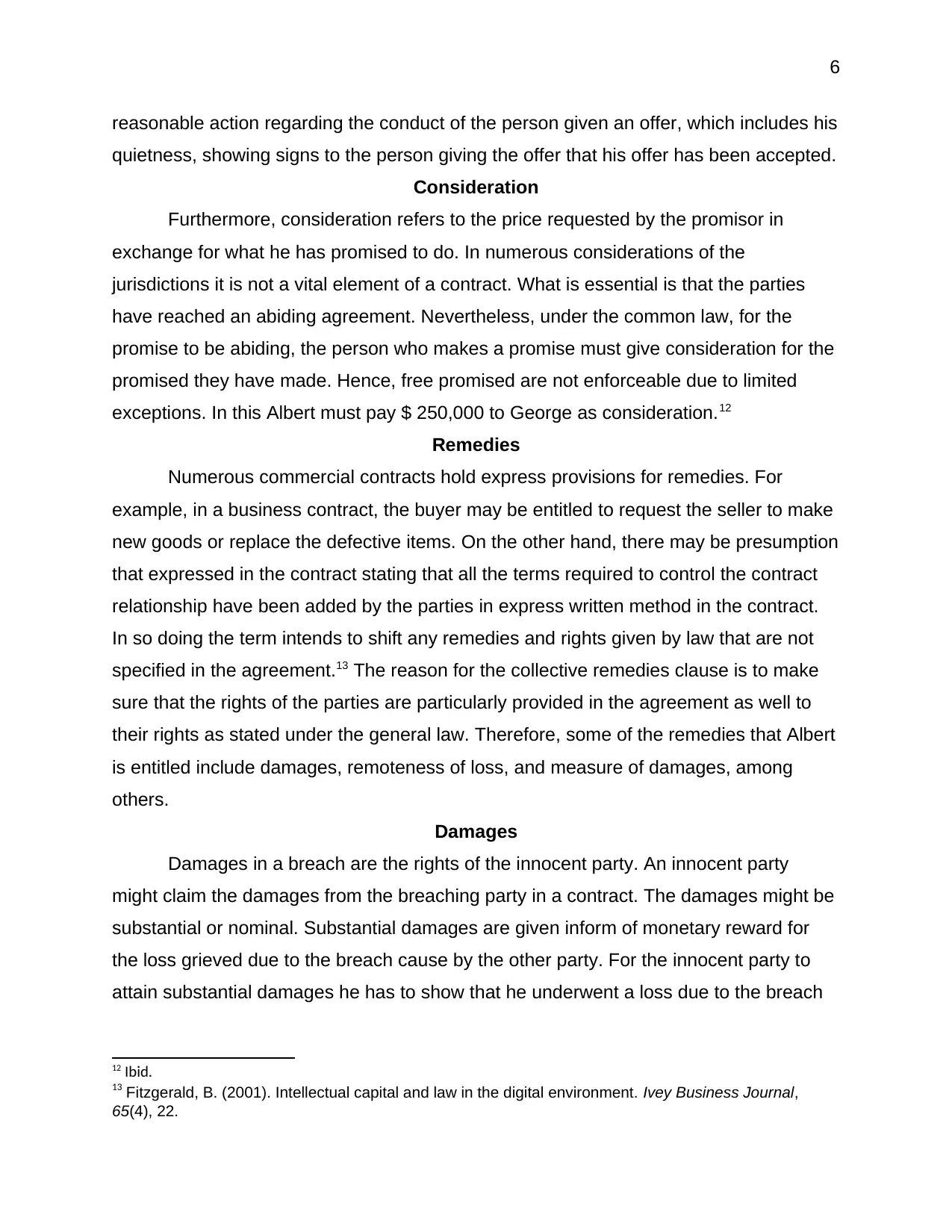
6
reasonable action regarding the conduct of the person given an offer, which includes his
quietness, showing signs to the person giving the offer that his offer has been accepted.
Consideration
Furthermore, consideration refers to the price requested by the promisor in
exchange for what he has promised to do. In numerous considerations of the
jurisdictions it is not a vital element of a contract. What is essential is that the parties
have reached an abiding agreement. Nevertheless, under the common law, for the
promise to be abiding, the person who makes a promise must give consideration for the
promised they have made. Hence, free promised are not enforceable due to limited
exceptions. In this Albert must pay $ 250,000 to George as consideration.12
Remedies
Numerous commercial contracts hold express provisions for remedies. For
example, in a business contract, the buyer may be entitled to request the seller to make
new goods or replace the defective items. On the other hand, there may be presumption
that expressed in the contract stating that all the terms required to control the contract
relationship have been added by the parties in express written method in the contract.
In so doing the term intends to shift any remedies and rights given by law that are not
specified in the agreement.13 The reason for the collective remedies clause is to make
sure that the rights of the parties are particularly provided in the agreement as well to
their rights as stated under the general law. Therefore, some of the remedies that Albert
is entitled include damages, remoteness of loss, and measure of damages, among
others.
Damages
Damages in a breach are the rights of the innocent party. An innocent party
might claim the damages from the breaching party in a contract. The damages might be
substantial or nominal. Substantial damages are given inform of monetary reward for
the loss grieved due to the breach cause by the other party. For the innocent party to
attain substantial damages he has to show that he underwent a loss due to the breach
12 Ibid.
13 Fitzgerald, B. (2001). Intellectual capital and law in the digital environment. Ivey Business Journal,
65(4), 22.
reasonable action regarding the conduct of the person given an offer, which includes his
quietness, showing signs to the person giving the offer that his offer has been accepted.
Consideration
Furthermore, consideration refers to the price requested by the promisor in
exchange for what he has promised to do. In numerous considerations of the
jurisdictions it is not a vital element of a contract. What is essential is that the parties
have reached an abiding agreement. Nevertheless, under the common law, for the
promise to be abiding, the person who makes a promise must give consideration for the
promised they have made. Hence, free promised are not enforceable due to limited
exceptions. In this Albert must pay $ 250,000 to George as consideration.12
Remedies
Numerous commercial contracts hold express provisions for remedies. For
example, in a business contract, the buyer may be entitled to request the seller to make
new goods or replace the defective items. On the other hand, there may be presumption
that expressed in the contract stating that all the terms required to control the contract
relationship have been added by the parties in express written method in the contract.
In so doing the term intends to shift any remedies and rights given by law that are not
specified in the agreement.13 The reason for the collective remedies clause is to make
sure that the rights of the parties are particularly provided in the agreement as well to
their rights as stated under the general law. Therefore, some of the remedies that Albert
is entitled include damages, remoteness of loss, and measure of damages, among
others.
Damages
Damages in a breach are the rights of the innocent party. An innocent party
might claim the damages from the breaching party in a contract. The damages might be
substantial or nominal. Substantial damages are given inform of monetary reward for
the loss grieved due to the breach cause by the other party. For the innocent party to
attain substantial damages he has to show that he underwent a loss due to the breach
12 Ibid.
13 Fitzgerald, B. (2001). Intellectual capital and law in the digital environment. Ivey Business Journal,
65(4), 22.
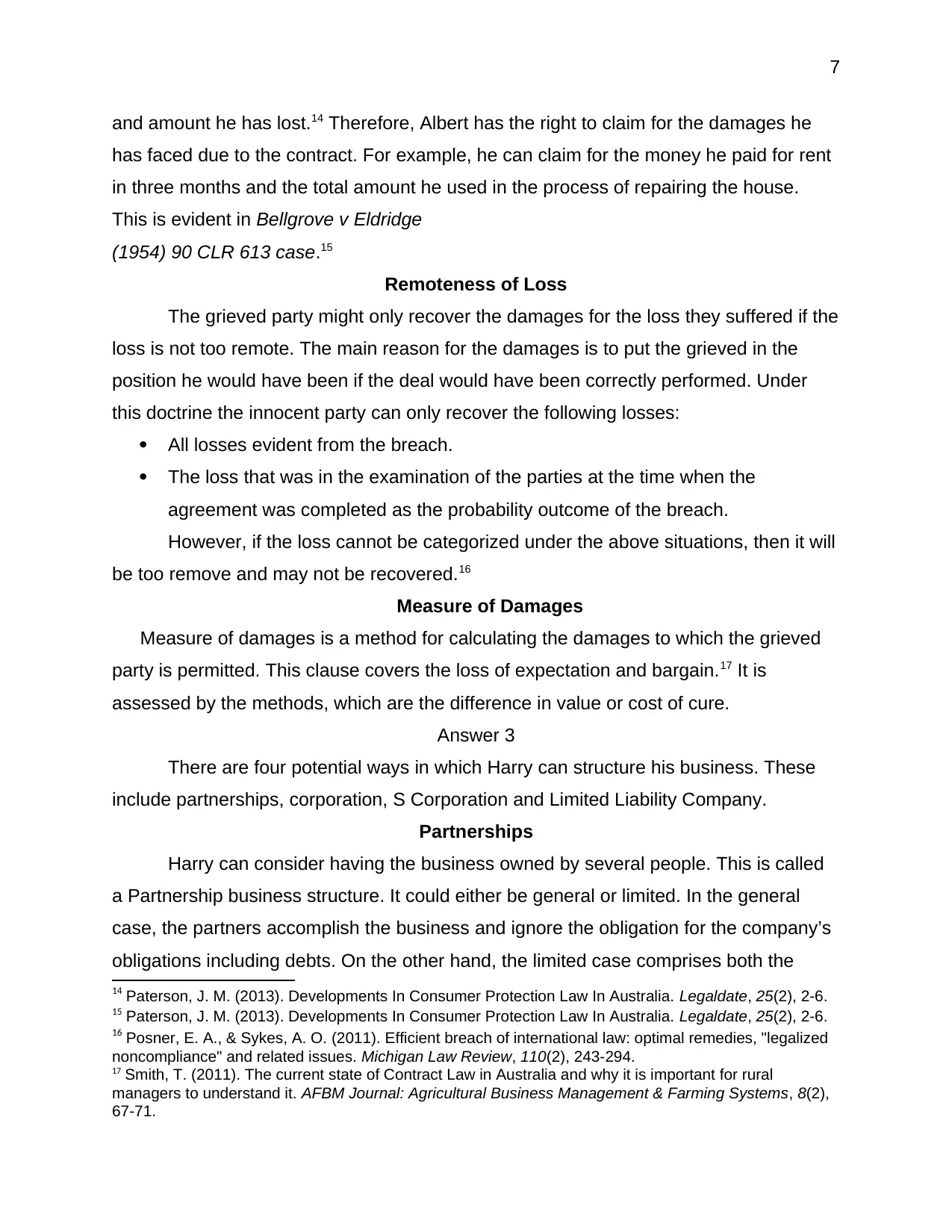
7
and amount he has lost.14 Therefore, Albert has the right to claim for the damages he
has faced due to the contract. For example, he can claim for the money he paid for rent
in three months and the total amount he used in the process of repairing the house.
This is evident in Bellgrove v Eldridge
(1954) 90 CLR 613 case.15
Remoteness of Loss
The grieved party might only recover the damages for the loss they suffered if the
loss is not too remote. The main reason for the damages is to put the grieved in the
position he would have been if the deal would have been correctly performed. Under
this doctrine the innocent party can only recover the following losses:
All losses evident from the breach.
The loss that was in the examination of the parties at the time when the
agreement was completed as the probability outcome of the breach.
However, if the loss cannot be categorized under the above situations, then it will
be too remove and may not be recovered.16
Measure of Damages
Measure of damages is a method for calculating the damages to which the grieved
party is permitted. This clause covers the loss of expectation and bargain.17 It is
assessed by the methods, which are the difference in value or cost of cure.
Answer 3
There are four potential ways in which Harry can structure his business. These
include partnerships, corporation, S Corporation and Limited Liability Company.
Partnerships
Harry can consider having the business owned by several people. This is called
a Partnership business structure. It could either be general or limited. In the general
case, the partners accomplish the business and ignore the obligation for the company’s
obligations including debts. On the other hand, the limited case comprises both the
14 Paterson, J. M. (2013). Developments In Consumer Protection Law In Australia. Legaldate, 25(2), 2-6.
15 Paterson, J. M. (2013). Developments In Consumer Protection Law In Australia. Legaldate, 25(2), 2-6.
16 Posner, E. A., & Sykes, A. O. (2011). Efficient breach of international law: optimal remedies, "legalized
noncompliance" and related issues. Michigan Law Review, 110(2), 243-294.
17 Smith, T. (2011). The current state of Contract Law in Australia and why it is important for rural
managers to understand it. AFBM Journal: Agricultural Business Management & Farming Systems, 8(2),
67-71.
and amount he has lost.14 Therefore, Albert has the right to claim for the damages he
has faced due to the contract. For example, he can claim for the money he paid for rent
in three months and the total amount he used in the process of repairing the house.
This is evident in Bellgrove v Eldridge
(1954) 90 CLR 613 case.15
Remoteness of Loss
The grieved party might only recover the damages for the loss they suffered if the
loss is not too remote. The main reason for the damages is to put the grieved in the
position he would have been if the deal would have been correctly performed. Under
this doctrine the innocent party can only recover the following losses:
All losses evident from the breach.
The loss that was in the examination of the parties at the time when the
agreement was completed as the probability outcome of the breach.
However, if the loss cannot be categorized under the above situations, then it will
be too remove and may not be recovered.16
Measure of Damages
Measure of damages is a method for calculating the damages to which the grieved
party is permitted. This clause covers the loss of expectation and bargain.17 It is
assessed by the methods, which are the difference in value or cost of cure.
Answer 3
There are four potential ways in which Harry can structure his business. These
include partnerships, corporation, S Corporation and Limited Liability Company.
Partnerships
Harry can consider having the business owned by several people. This is called
a Partnership business structure. It could either be general or limited. In the general
case, the partners accomplish the business and ignore the obligation for the company’s
obligations including debts. On the other hand, the limited case comprises both the
14 Paterson, J. M. (2013). Developments In Consumer Protection Law In Australia. Legaldate, 25(2), 2-6.
15 Paterson, J. M. (2013). Developments In Consumer Protection Law In Australia. Legaldate, 25(2), 2-6.
16 Posner, E. A., & Sykes, A. O. (2011). Efficient breach of international law: optimal remedies, "legalized
noncompliance" and related issues. Michigan Law Review, 110(2), 243-294.
17 Smith, T. (2011). The current state of Contract Law in Australia and why it is important for rural
managers to understand it. AFBM Journal: Agricultural Business Management & Farming Systems, 8(2),
67-71.
Paraphrase This Document
Need a fresh take? Get an instant paraphrase of this document with our AI Paraphraser
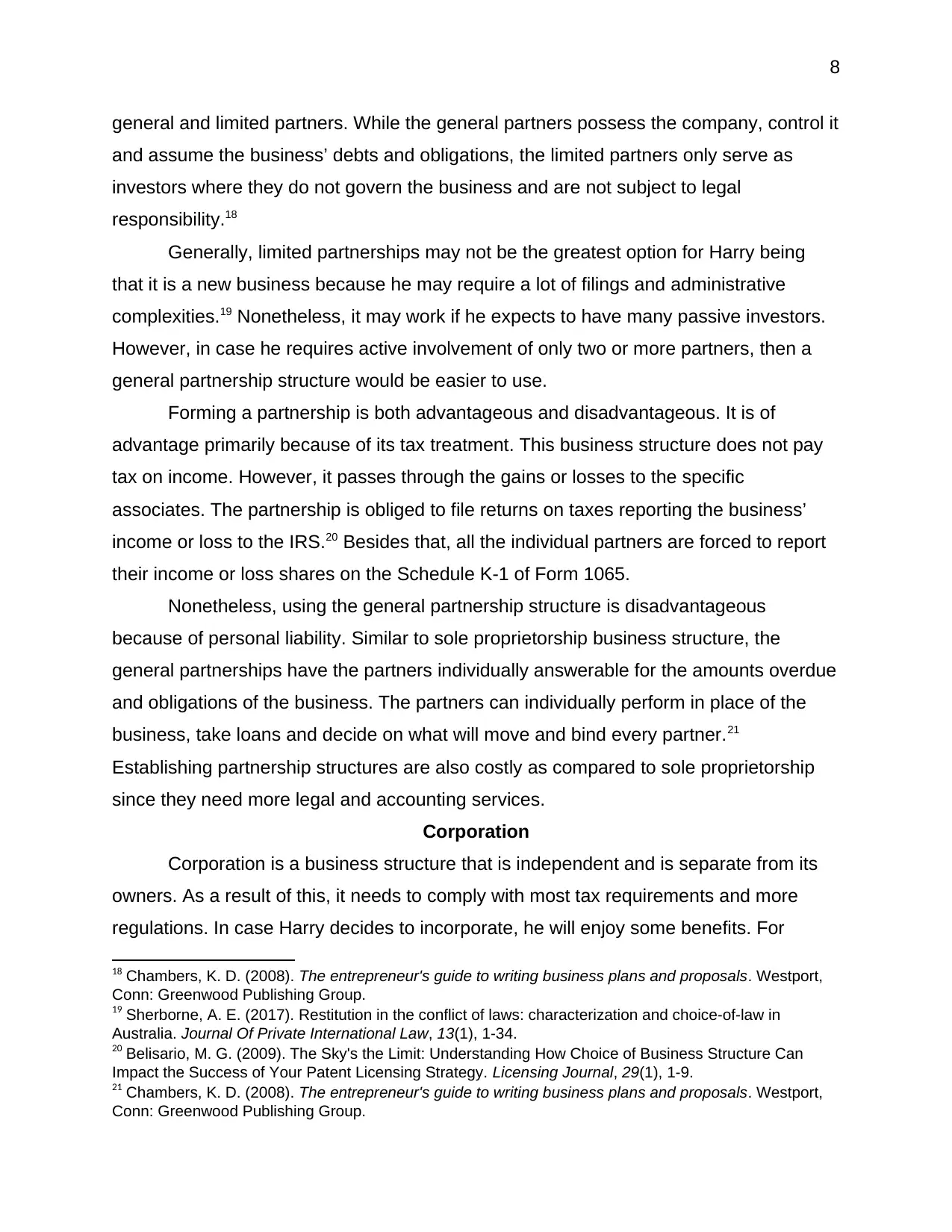
8
general and limited partners. While the general partners possess the company, control it
and assume the business’ debts and obligations, the limited partners only serve as
investors where they do not govern the business and are not subject to legal
responsibility.18
Generally, limited partnerships may not be the greatest option for Harry being
that it is a new business because he may require a lot of filings and administrative
complexities.19 Nonetheless, it may work if he expects to have many passive investors.
However, in case he requires active involvement of only two or more partners, then a
general partnership structure would be easier to use.
Forming a partnership is both advantageous and disadvantageous. It is of
advantage primarily because of its tax treatment. This business structure does not pay
tax on income. However, it passes through the gains or losses to the specific
associates. The partnership is obliged to file returns on taxes reporting the business’
income or loss to the IRS.20 Besides that, all the individual partners are forced to report
their income or loss shares on the Schedule K-1 of Form 1065.
Nonetheless, using the general partnership structure is disadvantageous
because of personal liability. Similar to sole proprietorship business structure, the
general partnerships have the partners individually answerable for the amounts overdue
and obligations of the business. The partners can individually perform in place of the
business, take loans and decide on what will move and bind every partner.21
Establishing partnership structures are also costly as compared to sole proprietorship
since they need more legal and accounting services.
Corporation
Corporation is a business structure that is independent and is separate from its
owners. As a result of this, it needs to comply with most tax requirements and more
regulations. In case Harry decides to incorporate, he will enjoy some benefits. For
18 Chambers, K. D. (2008). The entrepreneur's guide to writing business plans and proposals. Westport,
Conn: Greenwood Publishing Group.
19 Sherborne, A. E. (2017). Restitution in the conflict of laws: characterization and choice-of-law in
Australia. Journal Of Private International Law, 13(1), 1-34.
20 Belisario, M. G. (2009). The Sky's the Limit: Understanding How Choice of Business Structure Can
Impact the Success of Your Patent Licensing Strategy. Licensing Journal, 29(1), 1-9.
21 Chambers, K. D. (2008). The entrepreneur's guide to writing business plans and proposals. Westport,
Conn: Greenwood Publishing Group.
general and limited partners. While the general partners possess the company, control it
and assume the business’ debts and obligations, the limited partners only serve as
investors where they do not govern the business and are not subject to legal
responsibility.18
Generally, limited partnerships may not be the greatest option for Harry being
that it is a new business because he may require a lot of filings and administrative
complexities.19 Nonetheless, it may work if he expects to have many passive investors.
However, in case he requires active involvement of only two or more partners, then a
general partnership structure would be easier to use.
Forming a partnership is both advantageous and disadvantageous. It is of
advantage primarily because of its tax treatment. This business structure does not pay
tax on income. However, it passes through the gains or losses to the specific
associates. The partnership is obliged to file returns on taxes reporting the business’
income or loss to the IRS.20 Besides that, all the individual partners are forced to report
their income or loss shares on the Schedule K-1 of Form 1065.
Nonetheless, using the general partnership structure is disadvantageous
because of personal liability. Similar to sole proprietorship business structure, the
general partnerships have the partners individually answerable for the amounts overdue
and obligations of the business. The partners can individually perform in place of the
business, take loans and decide on what will move and bind every partner.21
Establishing partnership structures are also costly as compared to sole proprietorship
since they need more legal and accounting services.
Corporation
Corporation is a business structure that is independent and is separate from its
owners. As a result of this, it needs to comply with most tax requirements and more
regulations. In case Harry decides to incorporate, he will enjoy some benefits. For
18 Chambers, K. D. (2008). The entrepreneur's guide to writing business plans and proposals. Westport,
Conn: Greenwood Publishing Group.
19 Sherborne, A. E. (2017). Restitution in the conflict of laws: characterization and choice-of-law in
Australia. Journal Of Private International Law, 13(1), 1-34.
20 Belisario, M. G. (2009). The Sky's the Limit: Understanding How Choice of Business Structure Can
Impact the Success of Your Patent Licensing Strategy. Licensing Journal, 29(1), 1-9.
21 Chambers, K. D. (2008). The entrepreneur's guide to writing business plans and proposals. Westport,
Conn: Greenwood Publishing Group.
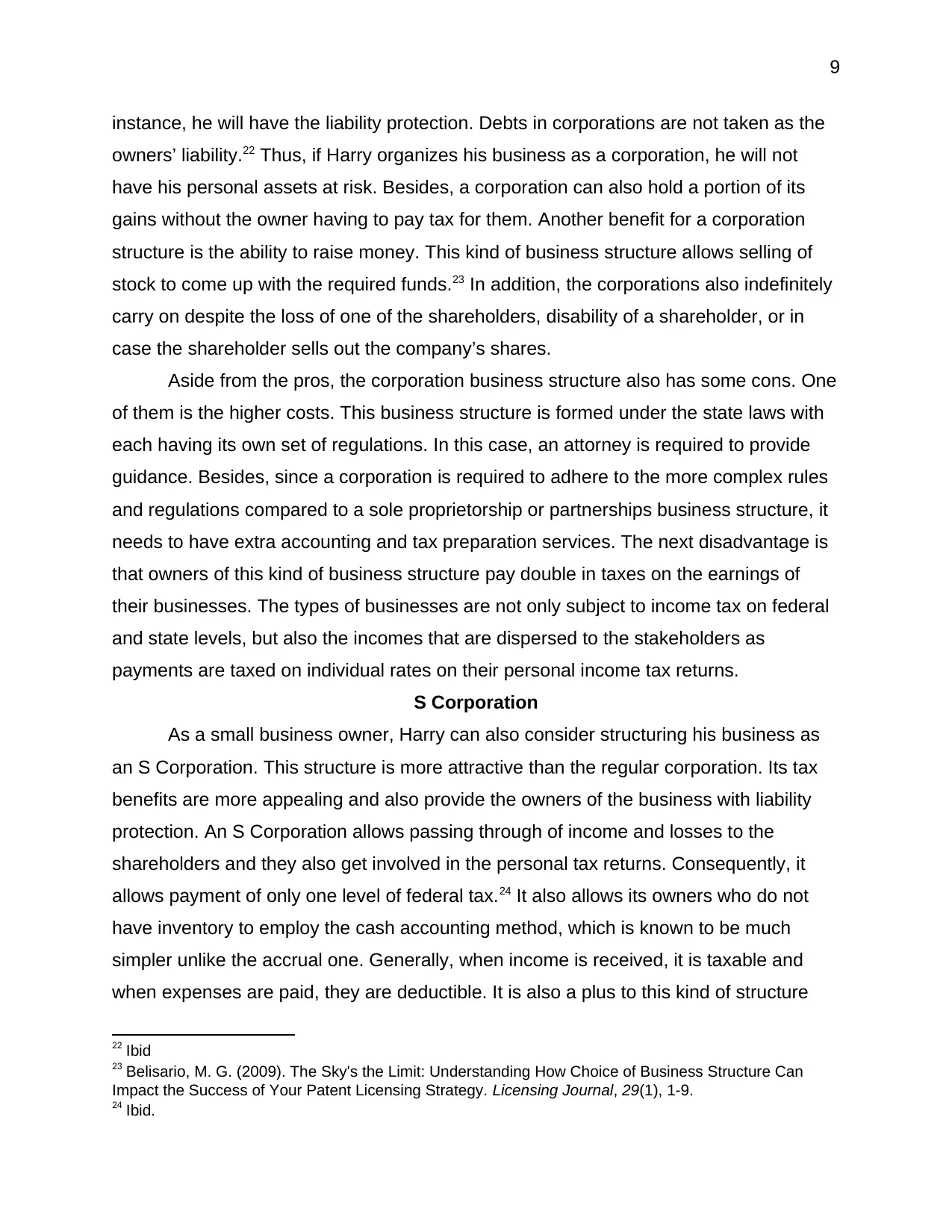
9
instance, he will have the liability protection. Debts in corporations are not taken as the
owners’ liability.22 Thus, if Harry organizes his business as a corporation, he will not
have his personal assets at risk. Besides, a corporation can also hold a portion of its
gains without the owner having to pay tax for them. Another benefit for a corporation
structure is the ability to raise money. This kind of business structure allows selling of
stock to come up with the required funds.23 In addition, the corporations also indefinitely
carry on despite the loss of one of the shareholders, disability of a shareholder, or in
case the shareholder sells out the company’s shares.
Aside from the pros, the corporation business structure also has some cons. One
of them is the higher costs. This business structure is formed under the state laws with
each having its own set of regulations. In this case, an attorney is required to provide
guidance. Besides, since a corporation is required to adhere to the more complex rules
and regulations compared to a sole proprietorship or partnerships business structure, it
needs to have extra accounting and tax preparation services. The next disadvantage is
that owners of this kind of business structure pay double in taxes on the earnings of
their businesses. The types of businesses are not only subject to income tax on federal
and state levels, but also the incomes that are dispersed to the stakeholders as
payments are taxed on individual rates on their personal income tax returns.
S Corporation
As a small business owner, Harry can also consider structuring his business as
an S Corporation. This structure is more attractive than the regular corporation. Its tax
benefits are more appealing and also provide the owners of the business with liability
protection. An S Corporation allows passing through of income and losses to the
shareholders and they also get involved in the personal tax returns. Consequently, it
allows payment of only one level of federal tax.24 It also allows its owners who do not
have inventory to employ the cash accounting method, which is known to be much
simpler unlike the accrual one. Generally, when income is received, it is taxable and
when expenses are paid, they are deductible. It is also a plus to this kind of structure
22 Ibid
23 Belisario, M. G. (2009). The Sky's the Limit: Understanding How Choice of Business Structure Can
Impact the Success of Your Patent Licensing Strategy. Licensing Journal, 29(1), 1-9.
24 Ibid.
instance, he will have the liability protection. Debts in corporations are not taken as the
owners’ liability.22 Thus, if Harry organizes his business as a corporation, he will not
have his personal assets at risk. Besides, a corporation can also hold a portion of its
gains without the owner having to pay tax for them. Another benefit for a corporation
structure is the ability to raise money. This kind of business structure allows selling of
stock to come up with the required funds.23 In addition, the corporations also indefinitely
carry on despite the loss of one of the shareholders, disability of a shareholder, or in
case the shareholder sells out the company’s shares.
Aside from the pros, the corporation business structure also has some cons. One
of them is the higher costs. This business structure is formed under the state laws with
each having its own set of regulations. In this case, an attorney is required to provide
guidance. Besides, since a corporation is required to adhere to the more complex rules
and regulations compared to a sole proprietorship or partnerships business structure, it
needs to have extra accounting and tax preparation services. The next disadvantage is
that owners of this kind of business structure pay double in taxes on the earnings of
their businesses. The types of businesses are not only subject to income tax on federal
and state levels, but also the incomes that are dispersed to the stakeholders as
payments are taxed on individual rates on their personal income tax returns.
S Corporation
As a small business owner, Harry can also consider structuring his business as
an S Corporation. This structure is more attractive than the regular corporation. Its tax
benefits are more appealing and also provide the owners of the business with liability
protection. An S Corporation allows passing through of income and losses to the
shareholders and they also get involved in the personal tax returns. Consequently, it
allows payment of only one level of federal tax.24 It also allows its owners who do not
have inventory to employ the cash accounting method, which is known to be much
simpler unlike the accrual one. Generally, when income is received, it is taxable and
when expenses are paid, they are deductible. It is also a plus to this kind of structure
22 Ibid
23 Belisario, M. G. (2009). The Sky's the Limit: Understanding How Choice of Business Structure Can
Impact the Success of Your Patent Licensing Strategy. Licensing Journal, 29(1), 1-9.
24 Ibid.
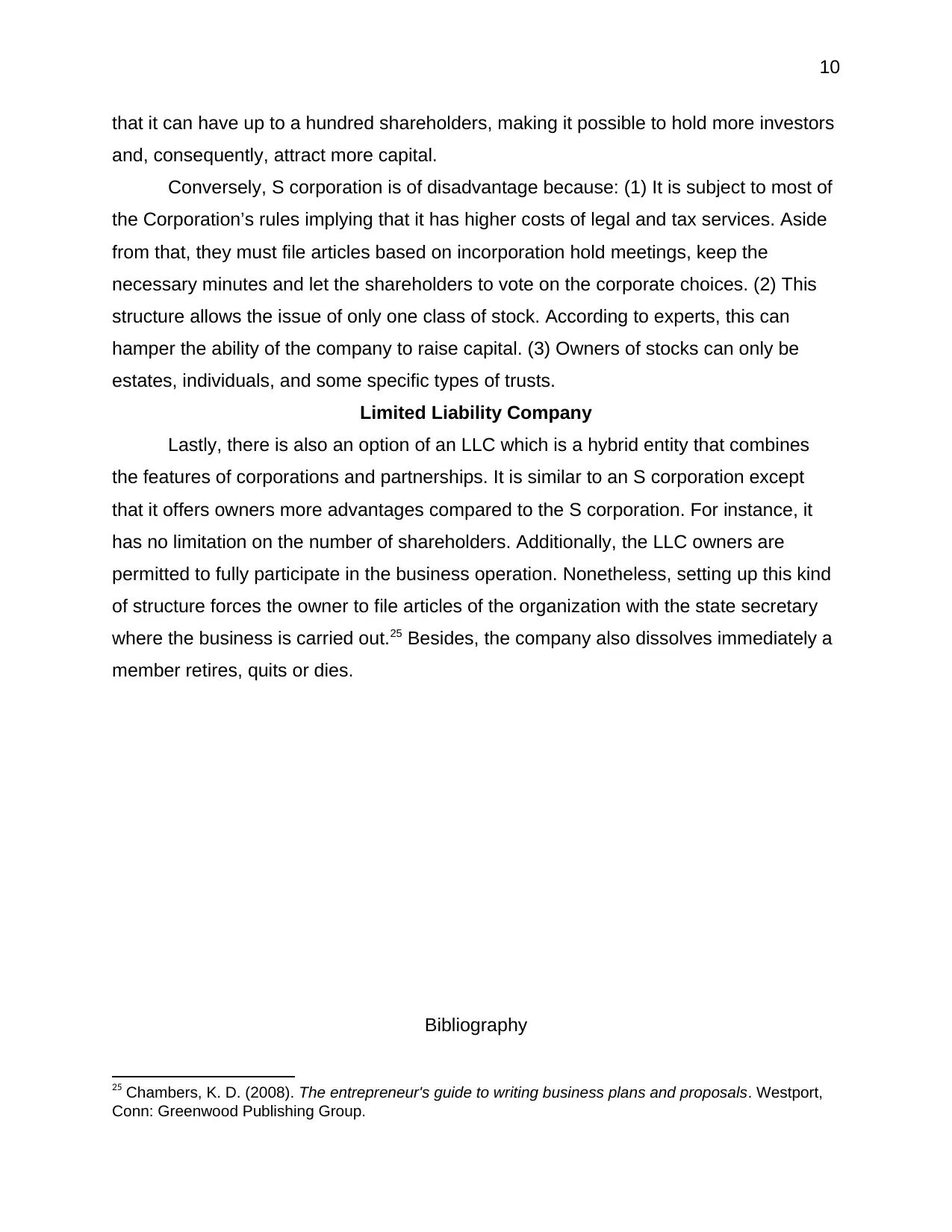
10
that it can have up to a hundred shareholders, making it possible to hold more investors
and, consequently, attract more capital.
Conversely, S corporation is of disadvantage because: (1) It is subject to most of
the Corporation’s rules implying that it has higher costs of legal and tax services. Aside
from that, they must file articles based on incorporation hold meetings, keep the
necessary minutes and let the shareholders to vote on the corporate choices. (2) This
structure allows the issue of only one class of stock. According to experts, this can
hamper the ability of the company to raise capital. (3) Owners of stocks can only be
estates, individuals, and some specific types of trusts.
Limited Liability Company
Lastly, there is also an option of an LLC which is a hybrid entity that combines
the features of corporations and partnerships. It is similar to an S corporation except
that it offers owners more advantages compared to the S corporation. For instance, it
has no limitation on the number of shareholders. Additionally, the LLC owners are
permitted to fully participate in the business operation. Nonetheless, setting up this kind
of structure forces the owner to file articles of the organization with the state secretary
where the business is carried out.25 Besides, the company also dissolves immediately a
member retires, quits or dies.
Bibliography
25 Chambers, K. D. (2008). The entrepreneur's guide to writing business plans and proposals. Westport,
Conn: Greenwood Publishing Group.
that it can have up to a hundred shareholders, making it possible to hold more investors
and, consequently, attract more capital.
Conversely, S corporation is of disadvantage because: (1) It is subject to most of
the Corporation’s rules implying that it has higher costs of legal and tax services. Aside
from that, they must file articles based on incorporation hold meetings, keep the
necessary minutes and let the shareholders to vote on the corporate choices. (2) This
structure allows the issue of only one class of stock. According to experts, this can
hamper the ability of the company to raise capital. (3) Owners of stocks can only be
estates, individuals, and some specific types of trusts.
Limited Liability Company
Lastly, there is also an option of an LLC which is a hybrid entity that combines
the features of corporations and partnerships. It is similar to an S corporation except
that it offers owners more advantages compared to the S corporation. For instance, it
has no limitation on the number of shareholders. Additionally, the LLC owners are
permitted to fully participate in the business operation. Nonetheless, setting up this kind
of structure forces the owner to file articles of the organization with the state secretary
where the business is carried out.25 Besides, the company also dissolves immediately a
member retires, quits or dies.
Bibliography
25 Chambers, K. D. (2008). The entrepreneur's guide to writing business plans and proposals. Westport,
Conn: Greenwood Publishing Group.
Secure Best Marks with AI Grader
Need help grading? Try our AI Grader for instant feedback on your assignments.
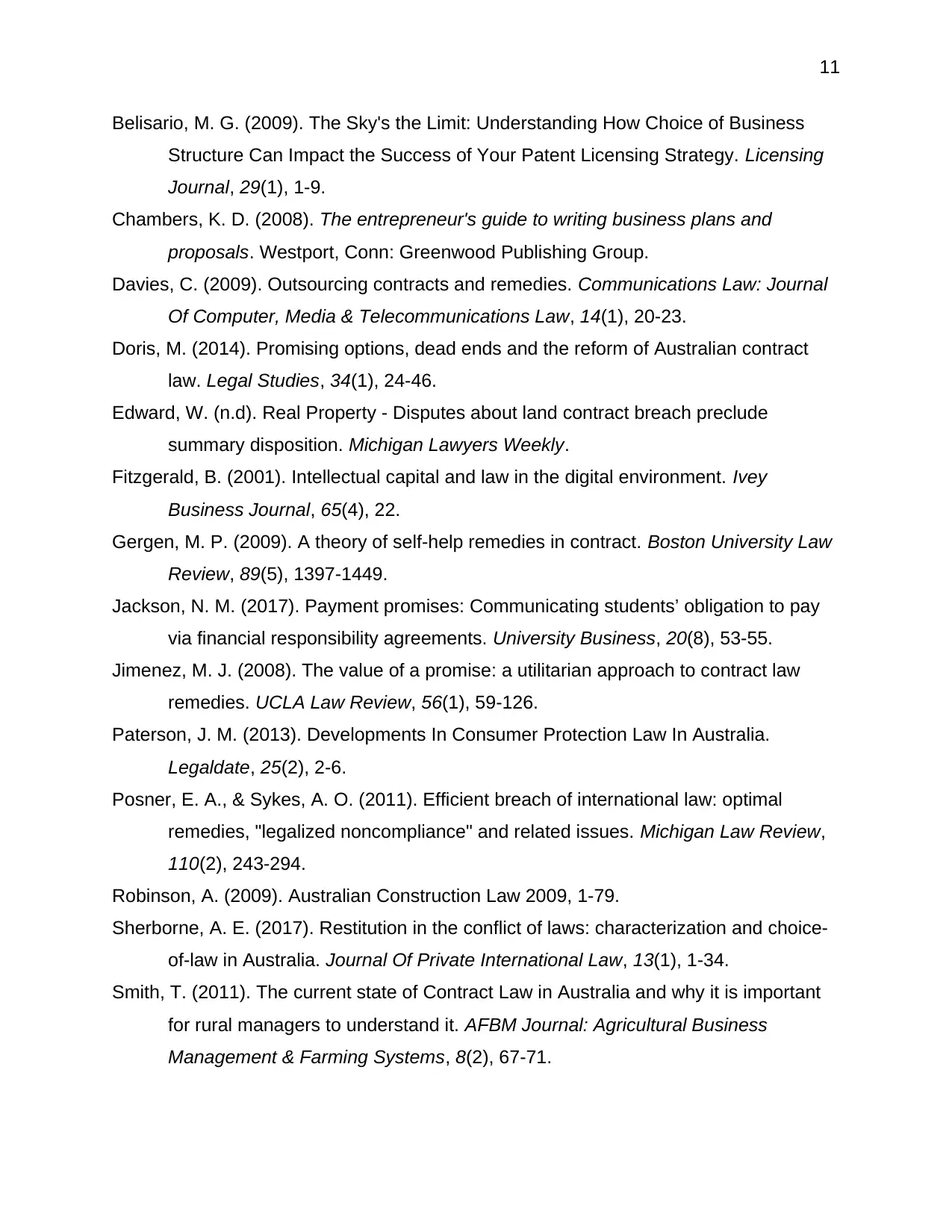
11
Belisario, M. G. (2009). The Sky's the Limit: Understanding How Choice of Business
Structure Can Impact the Success of Your Patent Licensing Strategy. Licensing
Journal, 29(1), 1-9.
Chambers, K. D. (2008). The entrepreneur's guide to writing business plans and
proposals. Westport, Conn: Greenwood Publishing Group.
Davies, C. (2009). Outsourcing contracts and remedies. Communications Law: Journal
Of Computer, Media & Telecommunications Law, 14(1), 20-23.
Doris, M. (2014). Promising options, dead ends and the reform of Australian contract
law. Legal Studies, 34(1), 24-46.
Edward, W. (n.d). Real Property - Disputes about land contract breach preclude
summary disposition. Michigan Lawyers Weekly.
Fitzgerald, B. (2001). Intellectual capital and law in the digital environment. Ivey
Business Journal, 65(4), 22.
Gergen, M. P. (2009). A theory of self-help remedies in contract. Boston University Law
Review, 89(5), 1397-1449.
Jackson, N. M. (2017). Payment promises: Communicating students’ obligation to pay
via financial responsibility agreements. University Business, 20(8), 53-55.
Jimenez, M. J. (2008). The value of a promise: a utilitarian approach to contract law
remedies. UCLA Law Review, 56(1), 59-126.
Paterson, J. M. (2013). Developments In Consumer Protection Law In Australia.
Legaldate, 25(2), 2-6.
Posner, E. A., & Sykes, A. O. (2011). Efficient breach of international law: optimal
remedies, "legalized noncompliance" and related issues. Michigan Law Review,
110(2), 243-294.
Robinson, A. (2009). Australian Construction Law 2009, 1-79.
Sherborne, A. E. (2017). Restitution in the conflict of laws: characterization and choice-
of-law in Australia. Journal Of Private International Law, 13(1), 1-34.
Smith, T. (2011). The current state of Contract Law in Australia and why it is important
for rural managers to understand it. AFBM Journal: Agricultural Business
Management & Farming Systems, 8(2), 67-71.
Belisario, M. G. (2009). The Sky's the Limit: Understanding How Choice of Business
Structure Can Impact the Success of Your Patent Licensing Strategy. Licensing
Journal, 29(1), 1-9.
Chambers, K. D. (2008). The entrepreneur's guide to writing business plans and
proposals. Westport, Conn: Greenwood Publishing Group.
Davies, C. (2009). Outsourcing contracts and remedies. Communications Law: Journal
Of Computer, Media & Telecommunications Law, 14(1), 20-23.
Doris, M. (2014). Promising options, dead ends and the reform of Australian contract
law. Legal Studies, 34(1), 24-46.
Edward, W. (n.d). Real Property - Disputes about land contract breach preclude
summary disposition. Michigan Lawyers Weekly.
Fitzgerald, B. (2001). Intellectual capital and law in the digital environment. Ivey
Business Journal, 65(4), 22.
Gergen, M. P. (2009). A theory of self-help remedies in contract. Boston University Law
Review, 89(5), 1397-1449.
Jackson, N. M. (2017). Payment promises: Communicating students’ obligation to pay
via financial responsibility agreements. University Business, 20(8), 53-55.
Jimenez, M. J. (2008). The value of a promise: a utilitarian approach to contract law
remedies. UCLA Law Review, 56(1), 59-126.
Paterson, J. M. (2013). Developments In Consumer Protection Law In Australia.
Legaldate, 25(2), 2-6.
Posner, E. A., & Sykes, A. O. (2011). Efficient breach of international law: optimal
remedies, "legalized noncompliance" and related issues. Michigan Law Review,
110(2), 243-294.
Robinson, A. (2009). Australian Construction Law 2009, 1-79.
Sherborne, A. E. (2017). Restitution in the conflict of laws: characterization and choice-
of-law in Australia. Journal Of Private International Law, 13(1), 1-34.
Smith, T. (2011). The current state of Contract Law in Australia and why it is important
for rural managers to understand it. AFBM Journal: Agricultural Business
Management & Farming Systems, 8(2), 67-71.
1 out of 11
Related Documents
Your All-in-One AI-Powered Toolkit for Academic Success.
+13062052269
info@desklib.com
Available 24*7 on WhatsApp / Email
![[object Object]](/_next/static/media/star-bottom.7253800d.svg)
Unlock your academic potential
© 2024 | Zucol Services PVT LTD | All rights reserved.





